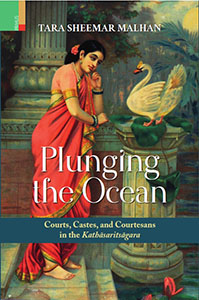
Plunging the Ocean: Courts, Castes and Courtesans in the Kathasaritsagara
AUTHOR- Tara Sheemar Malhan
| HB ₹995 . $59.95 . ₤49.95 |
||
INFORMATION
- AUTHOR : Tara Sheemar Malhan
- HB ISBN : 978-93-84082-86-4
- POD ISBN : 978-93-84092-59-7
- Year : 2017
- Extent : 332 pp.
- Discount available on checkout
- Usually dispatched within 3 to 5 working days.
INFORMATION
- AUTHOR – Tara Sheemar Malhan
- ISBN – 978-93-84082-86-4
- Year – 2017
- Extent: 400 + 40 coloured illustrations
- 10% discount + free shipping
- Usually dispatched within 3 to 5 working days.
The voluminous content of the Kathasaritsagara, a text meant for courtly entertainment, locating the various points of its retelling and recognizing the timelessness of the tales themselves. The volume weaves gender as the discursive mesh interweaving various themes such as caste, class, occupations, control and flow of resources or wealth, religious practices, sexuality and power structures to highlight the discourse of the text itself. In their creation and negotiation with the past, the narratives are seen as crucially demonstrating ‘social space’, in the organization of space itself and in the reflection of social relations of production and reproduction. The conclusion highlights the contradictions inherent in the characters and plots, in the folk antecedents and monarchical elite appropriation of the kathas, in conformity and subversion. The structures of power that create systems of knowledge are essentially projected as ominously omnipresent in the ‘Ocean of Stories’.
This book will be of lasting pertinence to not just scholars of History, Sociology, Gender Studies and Cultural Studies but also to the scholars of Folk Studies.
The Author
Tara Sheemar Malhan teaches history at Janki Devi Memorial College, University of Delhi. She has contributed papers to the Indian History Congress, and received an award from it for her presentation on ‘Merchants Tales: Wealth, Monarchy and Gender’. Her research interests include examining the intersections of caste, gender and power structures.
The voluminous content of the Kathasaritsagara, a text meant for courtly entertainment, locating the various points of its retelling and recognizing the timelessness of the tales themselves. The volume weaves gender as the discursive mesh interweaving various themes such as caste, class, occupations, control and flow of resources or wealth, religious practices, sexuality and power structures to highlight the discourse of the text itself. In their creation and negotiation with the past, the narratives are seen as crucially demonstrating ‘social space’, in the organization of space itself and in the reflection of social relations of production and reproduction. The conclusion highlights the contradictions inherent in the characters and plots, in the folk antecedents and monarchical elite appropriation of the kathas, in conformity and subversion. The structures of power that create systems of knowledge are essentially projected as ominously omnipresent in the ‘Ocean of Stories’.
This book will be of lasting pertinence to not just scholars of History, Sociology, Gender Studies and Cultural Studies but also to the scholars of Folk Studies.
The Author
Tara Sheemar Malhan teaches history at Janki Devi Memorial College, University of Delhi. She has contributed papers to the Indian History Congress, and received an award from it for her presentation on ‘Merchants Tales: Wealth, Monarchy and Gender’. Her research interests include examining the intersections of caste, gender and power structures.
Table of Contents
Table of Contents
| Preface | ix-x |
| Introduction | 1-42 |
| Space And Boundaries I: Men And Women In Cities | 43-83 |
| Space And Boundaries Ii: Men And Women In Villages And Forests | 84-111 |
| Work And Control: Occupations, Resources, And Reproduction | 112-157 |
| Elevated-Dependant Monarchy: Courtly Masculinities And Political Marriages | 158-193 |
| Performers Of Rituals: Magic Versus Austerity | 194-229 |
| Gendered Sexuality: Norms, Tradition, And Behaviour | 230-277 |
| Epilogue | 278-279 |
| Appendices | 280-320 |
| Bibliography | 321-327 |
| Index | 329-333 |




